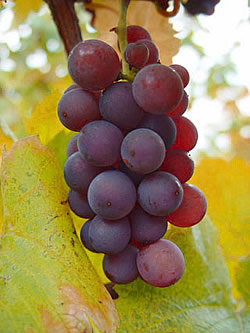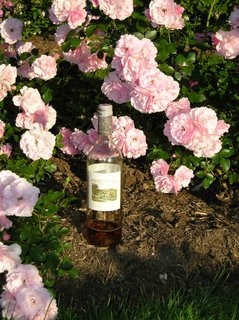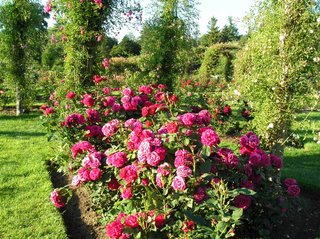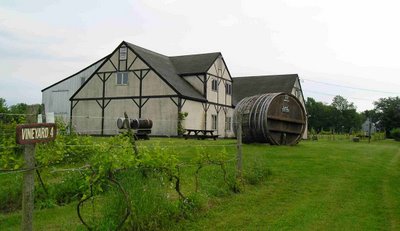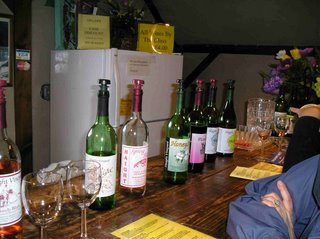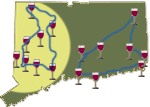Our next stop on the Connecticut Wine Trail takes us to New Hartford, about 25 miles west of Hartford, to the
Jerram winery. Once home to a dairy farm, this winery has to be one of the lovelier locations you'll find, if you like simple, unpretentious charm.
FacilitiesFor a get-away-from-it-all experience in the Connecticut countryside, Jerram is the place. The winery itself is located in the old horse barn on this sprawling farm property. And, the tasting room is cozily sheltered in the 1903 creamery, which has been restored to include an 18-foot wine bar and an art gallery (featuring a different artist every 6 weeks). Leisurely taking in the art (for sale), or the gardens on the grounds, is encouraged. Small groups also can enjoy a picnic with wine on one of the decks or patio, if the weather cooperates.
(I would love to show you photos, but Blogger has been a disaster for uploading photos lately -- nothing will upload today. My apologies. Perhaps I can edit this post at some point.)The winetasting experience on weekends is enhanced with crackers and a cheeseboard, featuring Connecticut or imported cheeses. All in all, sipping wines here is a relaxing and warm experience. A lot of wineries these days are building elaborate tasting room facilities with a Mediterranean flair -- drawing on the imagery we most associate with fine wine. Jerram, instead, goes with what it has to work and it feels authentic. For this reason, I give Jerram's facilities/ambience a
5 out of 5 score.
StaffOur pourer was owner Jim Jerram, who opened up with a genuine passion for his product once prompted by a few questions. The Jerrams have occupied the farm for roughly 30 years and have been making wine since 1982. With plenty of experience under their belts, they decided to open for business in 1999.
Though not effusive, Jerram is perfectly willing to share his accumulated wine wisdom if you demonstrate some interest. This is a definite complement to the tasting experience. I rate the knowledge and enthusiasm
4 out 5 points.
The WinesAs I noted previously, making wine in Connecticut can be a real struggle, especially when damp weather prevails. Jerram offers nine wines to sample for a $6 tasting fee -- the price includes a Jerram wine glass to take home. Unfortunately, I could taste evidence of the battle for ripeness in several of the wines.
The wines include some noble grapes and some not so noble grapes often grown in the area, such as seyval blanc and villard blanc. The flight of white wines included
White Frost, a light-bodied 100 percent chardonnay that would serve as a nice companion to white fish or light pasta fare;
Seyval Blanc, a dry crisp wine that does well in cold climates like ours but which, in this case, sported what I thought were off smells -- definitely a disappointment;
Gentle Shepherd, a slightly sweet blended wine with just a hint of orange peel that was my wife's favorite of the day; and
Aurora, which showed a little more sweetness and body to make it a decent match for some spicy fare.
The red flight included
S'il Vous Plait, a light cabernet franc that I found lacking in characteristic spice but with simple tart cherry flavors;
Highland Reserve, a cabernet franc/marechal foch blend that showed a little more spice with its cherry flavors but still not quite ripe;
Marechal Foch, a dry wine with a little more body that could go nicely with food but is a touch green; and
Nor'easter, a semi-sweet blend of chambourcin and foch -- while I don't typically like noticeable residual sweetness in my red wines, I thought this wine was interesting. A red that could go equally well with Asian beef dishes or chocolate.
The last wine we tried was
Vespers, a late-harvest dessert wine made from vignoles grapes. With its rich, honeyed aromas, the Vespers was very enjoyable.
I admire Jerram's adventurous approach to winemaking, trying numerous blends that make the most of the Northwest Connecticut terroir. And, in dry years, I'm sure they have a lot of success. But I found many of the '04s and '03s currently served to be lean. Still, a few wines were quite nice. I rate the wines a
6 out of 10.
Overall, Jerram nets a score of
15 out 20 points. Jerram is without a doubt a lovely destination that many people would enjoy for picnicing or for just soaking up the winetasting experience in a pastoral setting. There's a few wines to enjoy, but I'm not sure experienced tasters will find the $6 tasting fee worthwhile.
NOTE: While most reviews tend to look only at the wines, I believe visiting wineries is as much about an "experience" as it is about the quality of wines. Wineries probably get more tourists than wine geeks for visitors, and I think they're looking for a combination of comfortable, wine-focused facilities, knowledgable and passionate staff, and enjoyable wines. So, I'm assigning scores to each winery on a 20-point scale. 5 potential points for enjoyable, mood-enhancing ambience; 5 for knowledgable, enthusiastic staff; and 10 for quality wines. The scores are purely a result of my personal judgment; I have no relationship to any of the wineries.
